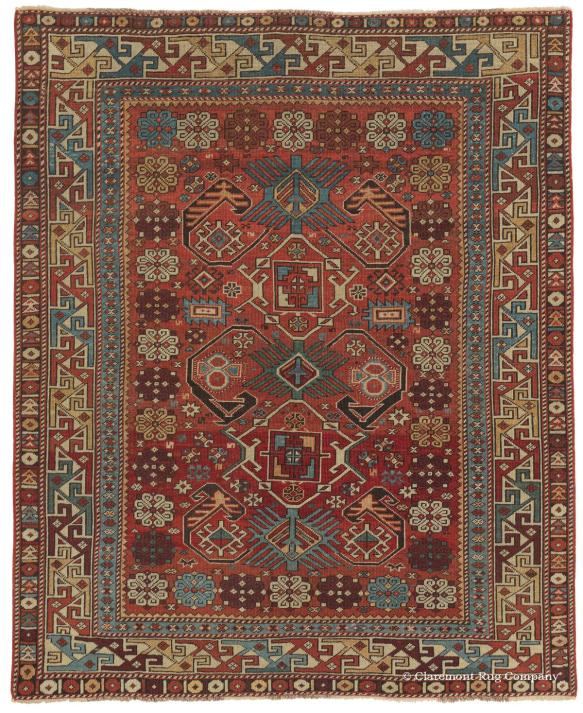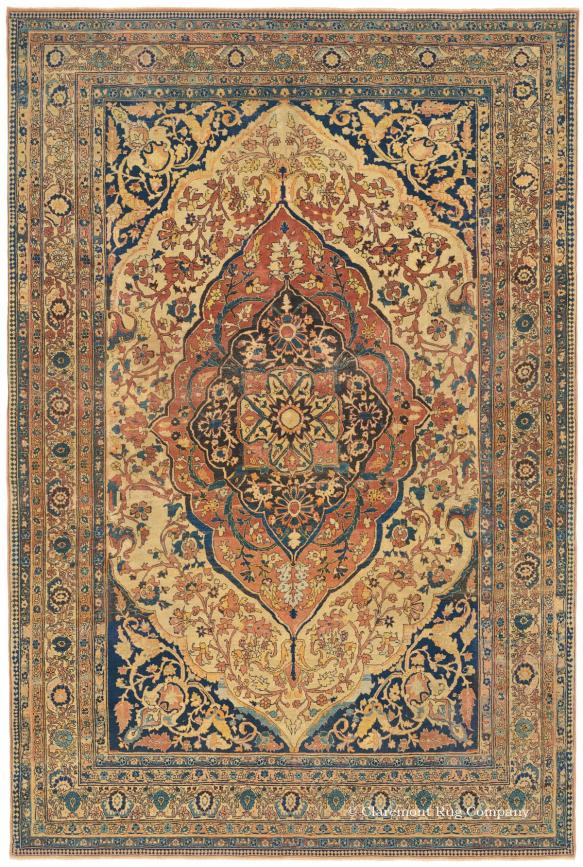The Caucasian nomad often knew only two environments during his entire lifetime: the high mountain meadow to which he brought his sheep to graze during the summer, and the deep valley below in which he waited out the winter. He lived in either a small tent blackened with smoke or a “kosh,” a dimly lit sod hut literally dug out of a hillside. The nomad learned to have gratitude for anything that provided comfort or beauty, and gratitude that he had life itself.
Perhaps as an expression of the deep joy of a people living and working close to the earth, the tribesperson wove rugs. And the carpets he created were magnificent! As a whole, the Caucasian antique carpet possesses an individuality, a boldness and deep sense of unity which is unsurpassed in the world of oriental rugs.

What is most striking about the Caucasian antique Oriental rug is its daring use of color. Balance of color is achieved here not by shading, but rather through contrast. The predominant reds, blues, greens and yellows would seem clashing to the mind, yet in actuality, the unerring confidence of the Caucasian craftsmen created color combinations so harmonious that they have been marveled at and studied by Western artists for centuries!
The Caucasus lies at the very heart of the rug-weaving world. Conquering armies, including those of Genghis Khan, Tamerlane and the Golden Horde, the Persians and Turks, stormed across these mountains for over a thousand years. They left behind the influence of every rug-making tradition from Egypt to China. The illiterate Caucasian tribesperson, working on a small, portable loom, has taken the form of more sophisticated weaving cultures. By transforming these designs into simple geometrical proportions, they have brought to them a new freshness and spontaneity.
The entire evolution of tribal weaving can be seen in Caucasian antique Oriental carpets. The dragon motif, boteh, flowerhead, arabesque, palmette, birds, animals, cloudband and crab designs are all present. Sometimes many of these are found in a single rug! In the midst of powerful geometrical diamonds there may be a tiny horse, dog or gazelle. Determination and intensity side-by-side with good humor and lightness demonstrate the dexterity of the Caucasian weaver.
Because of the physical lack of accessibility of the Caucasus to the outside world and the spiritedness of its peoples, natural dyestuffs were still used almost exclusively through 1920. This is over fifty years after the introduction of much easier-to-work-with, but infinitely less brilliant analine dyes. Similarly, it was not until World War I and the Bolshevik Revolution that Caucasian antique rugs were woven for export. The many fine examples from the late nineteenth and early twentieth centuries are clearly original, authentic tribal works of art in every regard.
In short, the Caucasian nomad wove antique rugs for his own daily use, to satisfy his singular sense of creativity and harmony. Accordingly, he put a level of care into his work which seems virtually incomprehensible to us today. The wool he used provided a superior level of resilience and luster because it was shorn from the sheep which he himself had grazed in high mountain pastures. It was then cleaned and washed repeatedly so that it could thoroughly absorb the vibrant vegetable dyes.
The Caucasian weaver believed that only after the material of his craft was brought to its ultimate state could he be inspired to create a rug of ultimate balance and harmony. For he did not merely see his finished carpet as the work of art. Instead, the art lay in performing each step of the process to completion.
It is of little wonder that the weavings of the numerous Caucasian tribal groups enjoy a universal popularity among collectors of oriental rugs today. Both the thick-piled carpets from the most mountainous regions of Kazak, Karabagh and Gendje, and the thinner, more closely shorn Kubas, Shirvans, and Daghestans, from the lower slopes descending toward the Caspian Sea, are equally enchanting. These are the last remnants of an ancient weaving tradition which has now all but vanished. They are living examples which speak to us of both the gaiety and deep understanding of life possessed by their creators—the mountain weavers of the Caucasus.
 Today’s sale at Sotheby’s of William Andrews Clark’s Sickle-leaf, Vine Scroll and Palmette ‘Vase’-technique carpet for $33.76 M has enormous significance not only for the antique Oriental rug field, but for the art world as a whole.
Today’s sale at Sotheby’s of William Andrews Clark’s Sickle-leaf, Vine Scroll and Palmette ‘Vase’-technique carpet for $33.76 M has enormous significance not only for the antique Oriental rug field, but for the art world as a whole.

 View cover-to-cover in
View cover-to-cover in 






